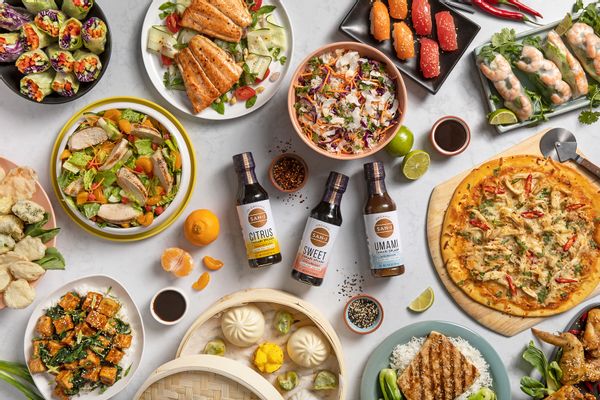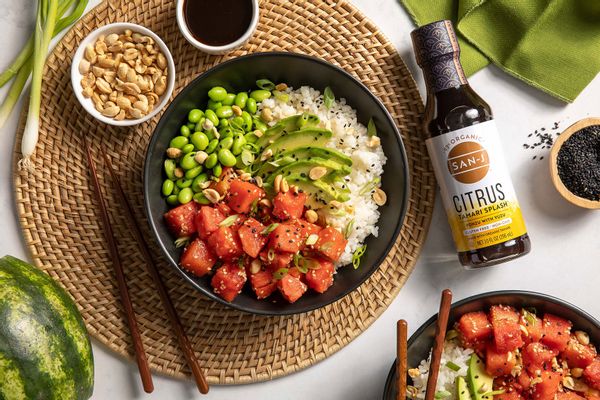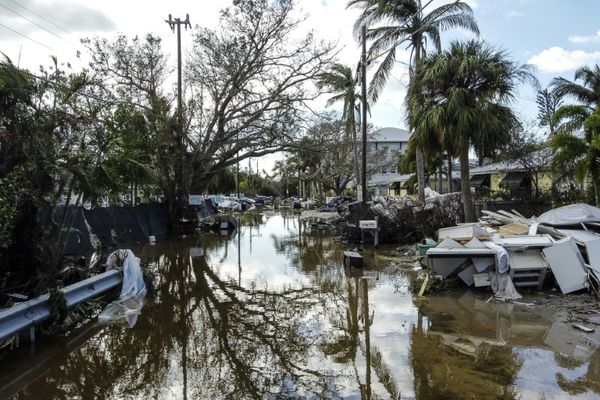
In many instances, soy sauce (or tamari) is an afterthought. Oftentimes sitting in a nondescript bottle on tables at sushi bars and Japanese restaurants, or sometimes kept in your refrigerator for drizzling over rice or adding to a stir-fry, the ubiquitous condiment is one that can most definitely be considered an unsung hero of the culinary world.
For those whose livelihood is defined by soy, though, that couldn't be any further from the truth.
San-J, which is celebrating its 220th anniversary this weekend (yes, you read that number correctly), has been in the soy and tamari business since the early 1800s, based in Japan. In the 1970s, the company opened a U.S. office.
President Takashi Sato, part of the founding family, is now at the helm, bridging the traditional Japanese origins of San-J with modern uses for the umami-laced ingredient (soy sauce caramel ice cream topping? Yes, please!) As he puts it, "As a child, soy sauce was so familiar to me that I didn't think it was anything special. But today, it’s my life."
Salon Food was able to speak with Sato about the foundations of the company, how it was inspired by Benihana, what differs soy and tamari, the brewing process, a conference called Kojicon and more
The following emailed interview has been lightly edited for clarity and length.
Can you talk a bit about the history of San-J? A 220-year anniversary is astonishing!
Since our inception in 1804, we have been manufacturing miso and tamari mainly in the Chubu region (central region of Japan). In 1978, we established a sales office in the United States due to the efforts of my father. Usually, it is the first-born son who takes over the family business. Since he was the second son, he joined Toyota to make a living on his own and was in charge of overseas sales. He often visited the U.S. on business and took American customers out to dinner – particularly to Benihana, whose founder Rocky Aoki was a high school classmate of his.
As you know, Benihana grills meat and shrimp on a griddle, using soy sauce as a seasoning. In the 70s, when soy sauce was not used for anything other than sushi, there were many Americans who were impressed by how delicious this other application was. Seeing this, my father thought “it’s fun to sell Toyota cars, but it would be even more exciting to sell soy sauce in the United States”. So he left Toyota and opened a soy sauce import and sales office in the U.S.
This is the beginning of our business. In that sense, Benihana is a benefactor. I was able to connect with Rocky Aoki's daughter, (actress and supermodel) Devon Aoki, and we exchanged DMs after I posted a story about my father and Rocky Aoki on my Instagram. I even got a video message from his son (DJ and electronic dance music record producer) Steve Aoki. They are celebrities, but very polite and nice, and I felt their love and respect for their father (Mr. Rocky Aoki) through our conversation.
At the time that we started importing and selling, Kikkoman already had the top share in the United States. How should we differentiate ourselves from them? That's when my father met the hippies. It was the 70s, so hippies were still very active. They practiced a way of living according to the laws of nature as much as possible.
Impressed by their way of thinking, my father began to make "soy sauce for hippies" – an organic soy sauce with no additives. At that time, soy sauce without chemical preservatives was very rare, and my father was able to fill this gap in the market. The natural food industry has a strong hippie influence - for example, Whole Foods head office is in Austin TX which is a hippie town. Wild Oats, which was the second in the industry (and later acquired by Whole Foods), was in Boulder in Colorado, also a hippie town.
After that, sales volume increased steadily, so we built a factory in Virginia in 1987, where we are today.
I know that you're an 8th-generation soy sauce brewer, which is so incredible. Can you speak a bit to that?
As a child, soy sauce was so familiar to me that I didn't think it was anything special. But today, it’s my life. It’s an honor to continue the legacy of my family and uphold authentic Japanese fermentation traditions while also exploring modern innovations and techniques.
How exactly do soy and tamari differ?
The most significant difference is the raw materials. In general, typical soy sauce is made with 50% soybeans and 50% wheat, while most tamari is made from 100% soybeans. Since soybeans contain more protein than wheat (40% protein in soybeans and 10% in wheat), this soybean-only tamari contains a lot of protein-derived amino acids, resulting in a rich (or full-bodied) taste with a lot of umami.
In addition, the amount of water added is much smaller. Typical brewed soy sauce adds 1.3 times more water than solid ingredients (soybeans and wheat), but for SAN-J’s Organic Tamari, we add only 0.9 times more water than solid ingredients (soybeans) creating a very rich taste.
We only use high-quality soybeans and do not dilute them as much, which results in a premium Tamari that is superior to typical soy sauce.
It's said that San-J's artisanal fermentation dates back to 1804. How is it still the same? How has modern equipment changed the process?
The basic concept is the same. However, we continue to make changes every year to improve the process.
The size of our equipment, such as tanks and steaming kettles, has been increased so that large quantities can be made. It is manufactured in a cleaner environment and is designed to prevent bacteria from entering, which is not desirable for tamari brewing. It’s designed to have precise control over the temperature and humidity in order to achieve the best quality.
Moreover, we prioritize the safety of our employees, and continue to make changes that make the environment as safe as possible.
How is the manufacturing process for low-sodium soy different from traditional soy?
The production is brewed in the traditional way as in the old days, but only the salt is removed at the end. Since the molecular weight of salt is very small, we use a special membrane that filters it through very small holes that allows only these molecules to pass through. If you remove the salt from the beginning, it will spoil during the fermentation period, so it must be done at the end.
Of course, gluten is a major component of soy sauce, but San-J has been producing wheat-free tamari for over 200 years. What initially caused brewers to want to start experimenting with wheat-free soy?
In fact, the order is opposite. The origin of Japanese soy sauce is miso that came from China, but this miso was made only from soybeans. When making this paste-like miso, the liquid that accumulated on the surface of the miso paste by adding too much water began to be sold as a liquid seasoning, which is the beginning of Japanese soy sauce. The word "tamari" itself is "liquid that has accumulated on the surface of miso".
Since it was born as a by-product of miso made from soybeans, the original ingredient was only soybeans. In the process of tamari being spread to various parts of Japan, wheat also came to be used. Therefore, tamari made with only soybeans was first distributed, and wheat was added later.
Why did wheat come to be used? There are several reasons: Wheat is cheaper; Wheat has a high sugar content, so fermentation occurs quickly, which shortens the production period; [And] wheat has a high sugar content, so alcoholic fermentation is also active, and the aroma becomes stronger. In the past, sushi restaurants were not equipped with refrigeration facilities when eating sushi, so there were many fish that were slightly rotten. Therefore, soy sauce with a strong aroma was preferred to mask the fishy odor.

I would love to hear an abridged history of soy/tamari, as well as what led to your family originally becoming involved in the practice?
Originally, my family was a shipping wholesaler. They used many boats to run a logistics business in the rivers flowing through the Nobi Plain(濃尾平野).
However, one day, they were ordered by a lord in the region at the time to go ashore and make soy sauce. The lord was trying to revitalize the economy by making processed products using soybeans and selling the processed products outside the domain.
The Sato family was chosen for the following reason. Soy sauce and sake were often provided by local notables. Not only did they have a large amount of land to build a factory, but in the case of products with a long manufacturing period, cash was spent from the purchase of raw materials [to] manufacturing [to] sales to the collection of payment. Therefore, only families that not only had land, but also had sufficient funds, could do this business.
The logo of our founding company is a three-line overlapping flag, which represents the three rivers — Ibi River, Kiso River, and Nagara River — from when we were a shipping wholesaler, and we used to hang the flag on the top of the boat. Even after we came ashore as a soy sauce maker, we continued to use that mark as the logo.
I know that San-J doesn't sell non-brewed soy. What does that mean?
We do not make any non-brewed soy sauce. Our Tamari Soy Sauce is all brewed. Tamari is our signature product, made with 100% soy and no wheat. We also make Shoyu, which is also categorized as “koikuchi” soy sauce/typical soy sauce which is made with 50% soy and 50% wheat. Shoyu means “soy sauce” in Japanese but when people say “shoyu” in Japan, it typically refers to “koikuchi” soy sauce.
In addition, we produce a product called No Soy Tamari. This is made from peas instead of soybeans so that people with soy allergies can enjoy it. By utilizing our many years of fermentation technology and experience, we can make the same delicious soy sauce with various ingredients.
Can you explain a bit about Kojicon?
Kojicon is an abbreviation for Koji Conference. Koji is the name of mold, a unique mold that exists only in Japan, and as a result, Japan fermentation is unique.
Fermentation using this Koji is attracting attention around the world. For example, Noma, a restaurant in Denmark, has been ranked first in the World Best 50 Restaurants for the past five years and has three Michelin stars. They became famous for using Koji in Danish cuisine.
The number of people in Europe and the United States who are interested in Koji is increasing, but there is still not enough information. Therefore, experts have come together to launch information sessions on fermentation using Koji – a.k.a. Kojicon. The original proponent was a man named Rich Shih, who wrote a book called "Koji Alchemy."
I have been invited to give lectures at Kojicon three times in the past. Although Koji itself is a fungus in Japan, there are very few Japanese people who talk about it at overseas conferences like this. Even here at Kojicon, the majority of people are non-Japanese. This is a good thing, but there is still a lot of knowledge about Koji in Japan to be shared, so I would like to contribute to the development of Koji culture overseas by actively sharing it stateside.
I'm obsessed with all things salty-sweet, so the idea of the soy sauce caramel ice cream topping is right up my alley. Tell me a bit about how that came to be?
Sweet and salty combinations are known to create layers of flavor which many people find delicious. During soy sauce fermentation, soy protein is broken down into amino acids, creating a balanced flavor with saltiness, sweetness, sourness, bitterness, and umami. SAN-J Tamari has over 30% more umami than typical brewed soy sauce. Tamari gives the sauce not only saltiness, but richness and complexity.
What differs traditional tamari from tamari splash?
Tamari is a basic seasoning. Use our Tamari if you’d like to enjoy flavors of quality Tamari itself, or use it in cooking to enhance flavors of other ingredients.
Tamari Splash is a flavored-Tamari. We added distinct flavors to our signature Tamari to create a unique, tasty sauce.
Another difference is how you use the sauce. Tamari Splash is designed to be used in more casual ways without cooking involved. You can splash on these flavors like you do with ketchup or mustard onto the foods you already enjoy.

What are your favorite soy-based recipes?
It's very simple, but I love to eat steak with soy sauce and a little wasabi. Soy sauce goes well with a variety of meals other than Japanese food.
What is your favorite cooking memory involving soy or tamari?
As a brewer, I spend so much time with the production that cooking gets away from me. However, I love to hear stories from our staff. For example, a team member shared with me that they made “harumaki” a Japanese-styled fried spring roll, served with a tamari & mustard dipping sauce at a Thanksgiving dinner with her husband’s family. They loved it so much and it has become a holiday tradition since then.
How do you practice sustainability?
There are various approaches. Fermentation, which is the basis of soy sauce production, is a technology that controls spoilage. Therefore, this technology can be used to reuse things that would otherwise be thrown away.
Take the Pumpkin Challenge, for example. In this country, pumpkins are decorated on Halloween. When Halloween is over, they are thrown away. That's a shame. There are other ways to enjoy pumpkins – for example, if you decompose it with koji mold, it creates a delicious pumpkin amazake, a Japanese fermented sweet rice drink. After having fun on Halloween, I make an amazake using the pumpkin and drink it while thanking the pumpkin for decorating my house for a month. When I mentioned this on my Instagram, many people tried it and posted it.
We use unexpected ingredients and combine our technologies to create different kinds of soy sauces. I’ve experimented with grapes, seaweed, corn, black beans, and more. For example, the following is a Corn Soy Sauce and Black Bean Tamari developed in collaboration with the infamous Eleven Madison Park in New York.







